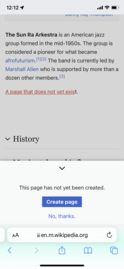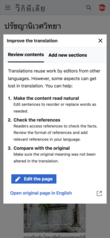编辑探索
Initially, this page is intended for Product Department staff who are seeking to expose a new contribution opportunity to volunteers. This page will enable these staff members to evaluate all of the existing editing entry points so that they can decide to do one of the following:
- Create a new entry point
- Integrate with an existing entry point
- Consolidate existing entry points
|
编辑探索
Help volunteers intuitively discover opportunities to improve Wikimedia Projects.
|
There are many paths people can take to contribute to Wikimedia projects.
This page offers an overview of the various entry points to said paths that are present within Wikimedia project interfaces.
Objectives
This page, and the practice of maintaining it, is designed to equip Wikimedia Foundation Product Teams with the information they need to help volunteers intuitively discover opportunities to improve Wikimedia Projects.
Entry Point Catalog
Persistent Entry Points
This section contains a list of the contextual editing entry points that are currently present within Wikimedia project interfaces, across platforms and devices. For definitions of each of the columns in the table below, please see the Glossary.
| Entry Point Name | Purpose | Platform(s) | Screenshot | Performance/Measurement | Documentation |
|---|---|---|---|---|---|
| Contribute Menus (desktop and mobile) | Make it easy for people to find actionable and intuitive ways to contribute by locating a range of self-guided edit opportunities in a location people can easily find and "reach" for.
|
Mobile Web (Minerva Neue) |   |
The work to define how we will evaluate the performance of this entry point will happen in phab:T286466. | Edit Discovery/Contribute menu, Contribute: a persistent entry point |
| #TODO: Move newcomer homepage (suggested edits) from "Contextual Entry Points" table |
Contextual Entry Points
This section contains a list of the contextual editing entry points that are currently present within Wikimedia project interfaces, across platforms and devices. For definitions of each of the columns in the table below, please see the Glossary.
| Entry Point Name | Contribution Type | Platform(s) | Screenshot(s) | Performance | Availability | Notes |
|---|---|---|---|---|---|---|
| Section edit link | Article edit | Web (desktop + mobile), Apps (iOS, Android) | 
|
#TODO | Everyone (logged in + out) | This entry point contains many different edit opportunities. |
| Full-page edit link | Article edit | Web (desktop) | 
|
#TODO | Everyone (logged in + out) | This entry point contains many different edit opportunities. |
| Edit selected content | Article edit | iOS, Android | 
|
#TODO | Everyone (logged in + out) | This entry point contains many different edit opportunities. It also opens the editing interface in the precise place someone was in while reading. |
| Start new topic on a page where discussions are hosted | Web (desktop, mobile) | 
|
Junior Contributors who open the New Topic Tool are ~1.3 times more likely to successfully publish a new topic than Junior Contributors who open the existing add new section workflow[1] | Everyone (logged in + out) | This entry point is scoped to a singular edit type: starting a new section/discussion on a page that hosts discussions. | |
| Reply | Reply to a specific comment on a page where discussions happen | Web (desktop) | 
|
People who have made <100 cumulative edits were 7.2 times more likely to publish a comment on desktop than those using page editing.[2] | Everyone (logged in + out. Details:Deployment Status) | This entry point is scoped to a singular edit type: posting a response to a comment on a page that hosts discussions. |
| Create page via red link | Create a page that does not currently exist | Web (mobile) | 
|
#TODO | Everyone (logged in + out. Details:Deployment Status) | This entry point supports many types of changes. Although, it is presented to people as having a singular purpose: to create a page that does not currently exist. |
| User homepage | A feed of numerous edits people can make. Each edit is scoped to a particular kind of change. | Web (mobile, desktop), Android App |  
|
#TODO | #TODO | This entry point offers people a variety of edits people they can choose to make. Each edit suggestion is scoped to a particular kind of change (e.g. adding reference(s), adding link(s), adding image(s), etc.). |
| New Translation | Translate an article from one language to another language | Web (desktop) | 
|
#TODO | #TODO | This entry point is scoped to a singular edit type: translating an article from one language into another. |
| Translation as alternative to create article from scratch | Translation (new article) | Web (desktop and mobile) |  
|
If there is a relevant suggestion based on the title it is shown in the invite. Otherwise, the invite is shown only once for the user. | Desktop (T216500) and Mobile (T298084) | |
| Review recent translations | Proofreading, and Translation (expand) | Web (mobile) |   
|
Research suggests that users can easily and quickly discover it and interpret as a signal that some action was needed for the article [1] | Logged-in users on mobile.
Articles published as a translation in the last 10 days, with less than 5 edits. The article has no other notices (to give priority to community added ones), and is not a redirect. |
T287236 |
| Translate a section the user recently edited in another language | Translation (expand) | Web (mobile) | 
|
On mobile, the user is in a page that they have edited in another language recently in their 10 latest significant edits (+500 bytes or more) for a section missing in the current language. | T287025 | |
| Surface missing languages to translate | Translation (new article) | Web (desktop and mobile) |  
|
Articles missing on a language relevant to the user. | Desktop (T290972) and Mobile (T298032). | |
| Search for missing language to translate | Translation (new article) | Web (mobile) | 
|
Research shows that searching for the availability of an article in a given language is often an initial step in the translation process.[2][3] | Logged-in users on mobile.
Searching for a language the article is not available in (and mobile translation is supported). |
T286470 |
| More options from language selector | Translation (new article) | Web (desktop) |  
|
The Language selector provides access to additional options from the bottom corner. Logged-in users on desktop where Content Translation is available have an option to translate the page into more languages. | T289840 | |
| Post-publish follow-up | Translation (expand), and Proofreading (secondary) | Web (mobile) | 
|
Logged-in user after publishing a translation for an article/section on mobile. | T241592 | |
| Post-edit suggestion | Suggested Edits | Web (mobile + desktop) | 
|
In analysis of the "add a link" funnel, we saw that 28% of desktop users and 11% of mobile users choose to do another task from the "post-edit dialog". | Any logged in user who has enabled the Newcomer Homepage and completed a Suggested Edit. | T301603 |
Inactive Entry Points
This section will contain a list of editing entry points that are no longer present within Wikimedia project interfaces, across platforms and devices.
Glossary
Entry Point Name: name of entry pointContribution Type: what content the entry point will lead people to change/contribute to- Examples: Article, file, discussion, image, infobox, etc.
Platform(s): the platform(s) the entry point is available on- Examples: mobile web, desktop web, Android, iOS, KaiOS, etc.
Screenshot(s): image(s) of the entry point being describedPerformance: what data/evidence do we have to help us understand the impact a given entry point has on people's likelihood to: A) make a constructive contribution and B) return to make more contributions- Examples: links to analyses, qualitative research studies, etc.
Availability: the conditions that must be met for an entry point to be available- Examples: account state (logged in/out), the tool(s) used to publish a piece of content (e.g. Content Translation: phab:T287236), the time that has elapsed since an article was published, the presence of issues/edit suggestion within the content someone is viewing (phab:T265163), user experience level, etc.
Notes: a free-form field for any information that may not fit in an existing column.- Examples: attributes of an entry point: "persistent," "opportunistic," "proactive," etc.
Contextual Entry Point: #TODOPersistent Entry Point: #TODO
